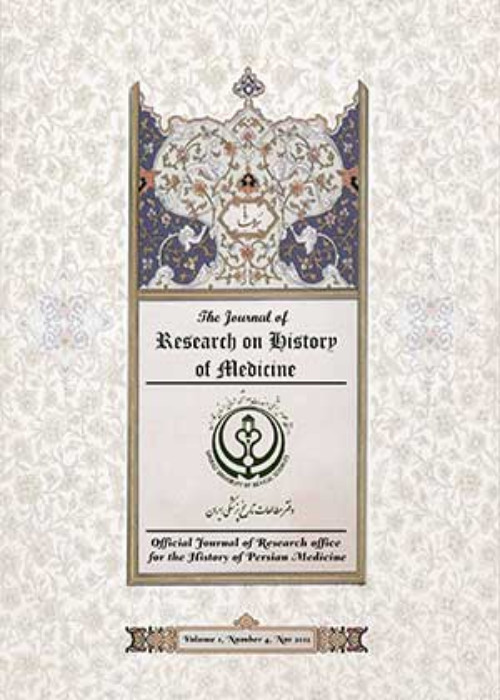فهرست مطالب
Journal of Research on History of Medicine
Volume:3 Issue: 3, Aug 2014
- تاریخ انتشار: 1393/05/31
- تعداد عناوین: 7
-
-
Page 113Background
Qutb al-Din al-Shiraziis known as a Persian philosopher, physician, physicist, mathematician and astronomer from the seventh century AD as well as the pioneer of Shiraz Medical doctrine. He has several books on medicine, philosophy, Quran, Hadith, physics, geography and mathematics. His medical books are “TohfeyeSadyeh”, ”Treatise on vitiligo”, “Treatise on ophthalmic diseases” and “Description on Avicenna’s Medical Poem”. Qutb al-Dinhas had a comprehensive discussion on medical ethics in the third chapter of “Fi-Bayan-el-Hajateela al-Tebbeva al-AttebbavaVasayahom” [The need to medicine and physicians and their recommendations] that is the most comprehensive treatise on medical ethics in ancient Persia.
MethodsIn this article, we have reviewed the third chapter of “Fi-Bayan-el-Hajateela alTebbeva al-AttebbavaVasayahom” and made a comparison between Qutb al-Din’s recommendations on medical ethics and classic ethical code.
ResultsQutb al-Din’s ethical recommendations for doctors are in ten groups which include believing in God and day of Judgment, recommending the good and prohibiting the bad, appreciating teachers, receiving no charge for medical education and medical practice, avoiding dangerous, fatal and abortive drugs, respecting the confidentiality and privacy of the patients, good interaction with the patients and justice in dealing with rich and poor patients and considering patients’ benefit.
ConclusionMultiple similarities, such as topics on confidentiality, justice and patient’s best interest, are present among these ethical systems. However, some differences also exist between the Qutb al-Din’s presented ethical code and classic one, mainly due to the difference in their philosophy of ethics.
-
Page 123Jondishapour School was the first center of cultural transmission in the world among various civilizations like the Greek, Syriac, Hindi, Chinese and Roman formed by permissive policies of Khosro Anushirvan in Iran. The idea that Iranian knowledge can be flourished with the help of progress made in science in different cultures was, for the first time, suggested by Khosro Anushirvan and his competent minister Buzarjmehr. Several meetings were held between scholars of different cultures and civilizations in the presence of the king and Sassanid sage. In addition, translation of the works from different languages and cultures to the Pahlavi was done and encouraged during this period and fortunately, despite the fall of the Sassanid emperor and Muslims attack on Iran, this policy continued without stop. But the centrality of Baghdad and dominance of Arabic language over Pahlavi language could affect only the change of the language, not the policy of the era. In fact, we can consider Jondishapour School as one of the main causes of promotion of Islamic culture and civilization.
-
Page 137The Fatimid era(358-567 AH /968-1171AD) was one of the most brilliant historical periods due to its intellectual and cultural achievements and successes. influencing an area beyond its boundaries. Due to their attempts, Cairo turned into one of the artistic, cultural, and scientific Islamic centers and it became the focus of research and science. During this period, there were numerous debates among doctors which led to the flowering of this science Different gifts were dedicated to the scholars’ tuition fees and physicians’ salaries. Whenever caliph identified a physician as qualified in his career, he was empowered and favored by the caliph, and became his close friend.Medicine was in the hands of Jewish and Christian physicians in Fatimid territory during Moez and Aziz caliphs, until the mid-fifth century.. This continued up to Alhakem period during which Sunni people attempted to challenge their authority and seize their position.Some specific diseases were more common in Egypt; including eye diseases, cholera, and plague which got epidemic successively because of the ongoing famine in Egypt.This study is a piece of library research which makes use of Arabic, Persian, and Latin sources regarding the development of Islamic medicine during the Fatimid period in Egypt.
-
Page 169Spine Surgery began its evolution in the beginning of the 19th century in order to reach nowadays the point of being considered an important subspecialty of Neurosurgery and Orthopaedics. The purpose of this historical review is the search and evaluation of the progress in spine surgery in the second half of the 20th century. This review concerns the evolution of this field in Greece. Special references are made to the achievements of this field, to the departments that practised it, to physicians and surgeons (orthopaedic surgeons, neurosurgeons, radiologists and rheumatologists) who developed this subspecialty and to clinical and scientific work of this time period. Eventually, the progress of medicine and technology who led to the first achievements of this subspecialty are shown and also that this progress followed the development of the National Healthcare System. In Greece, with small exceptions, the new techniques emerged with a certain delay.


